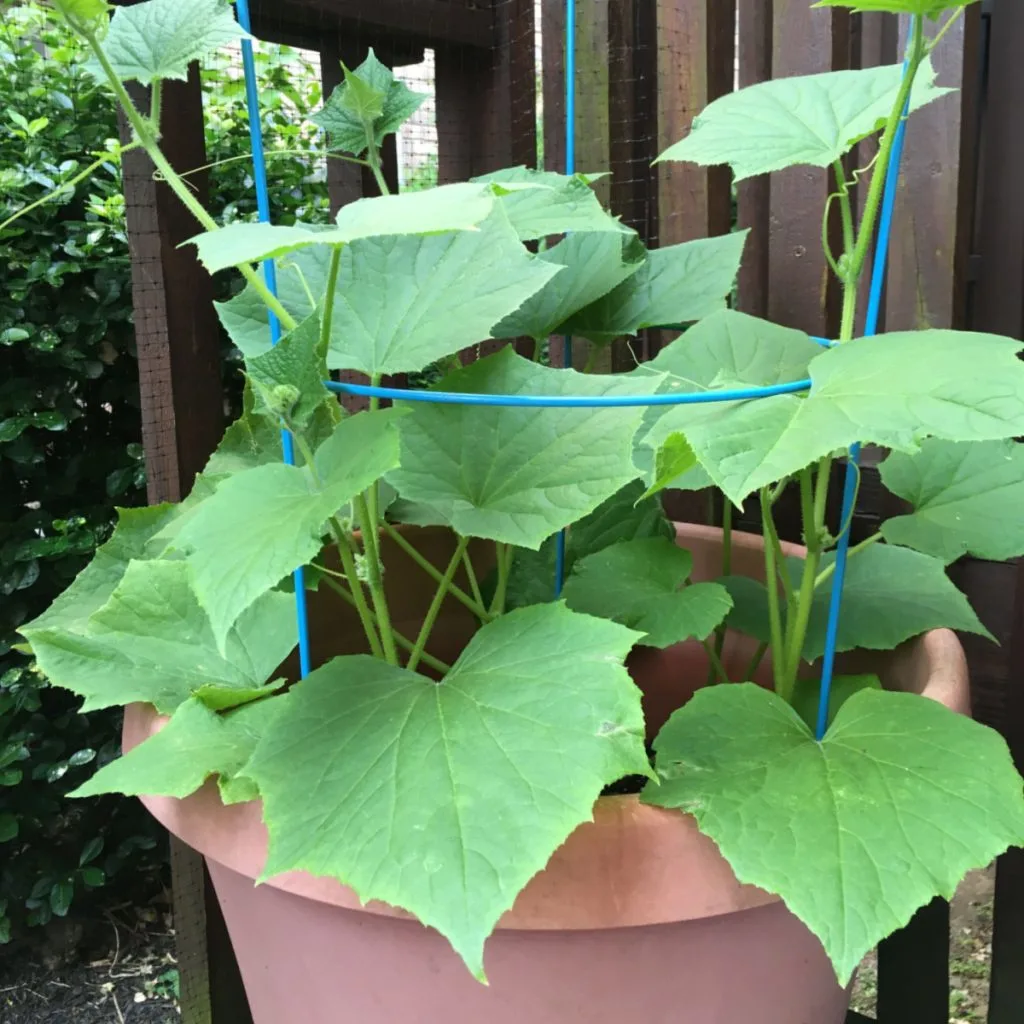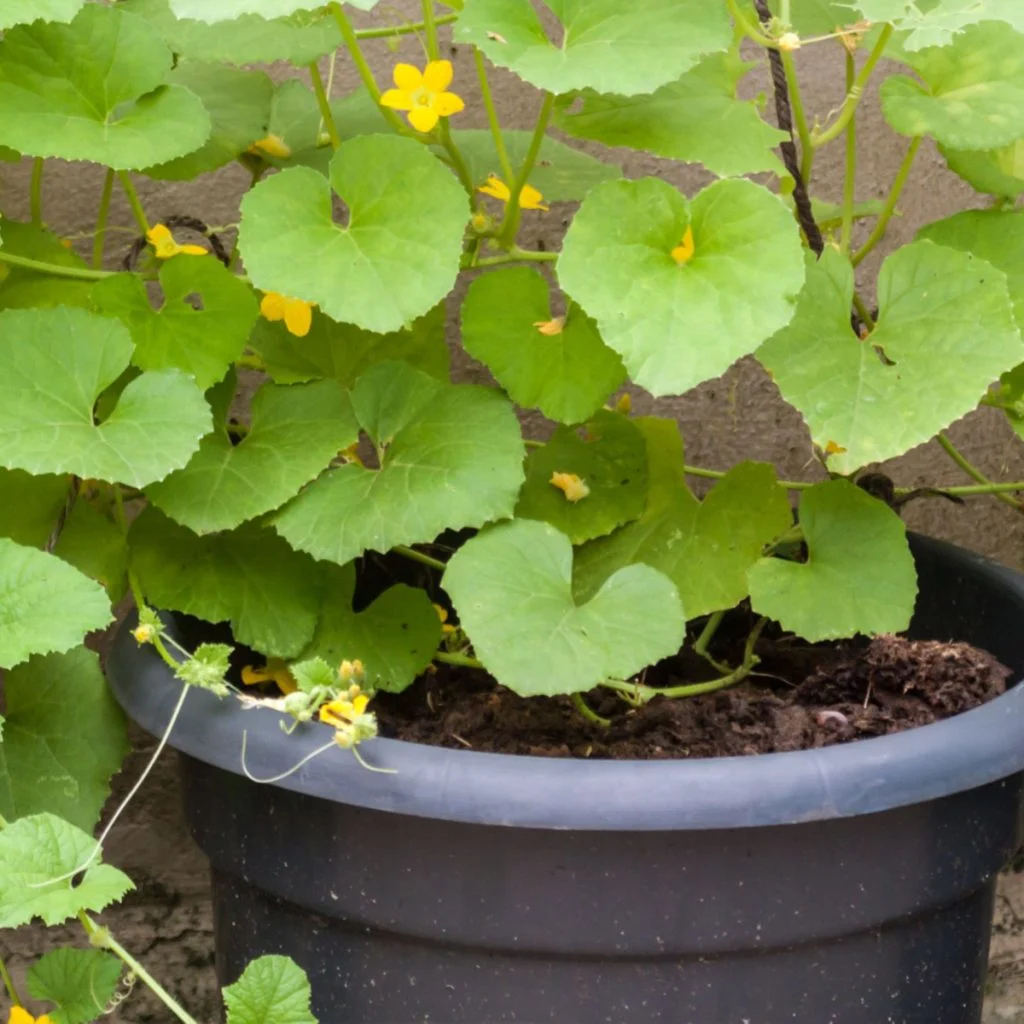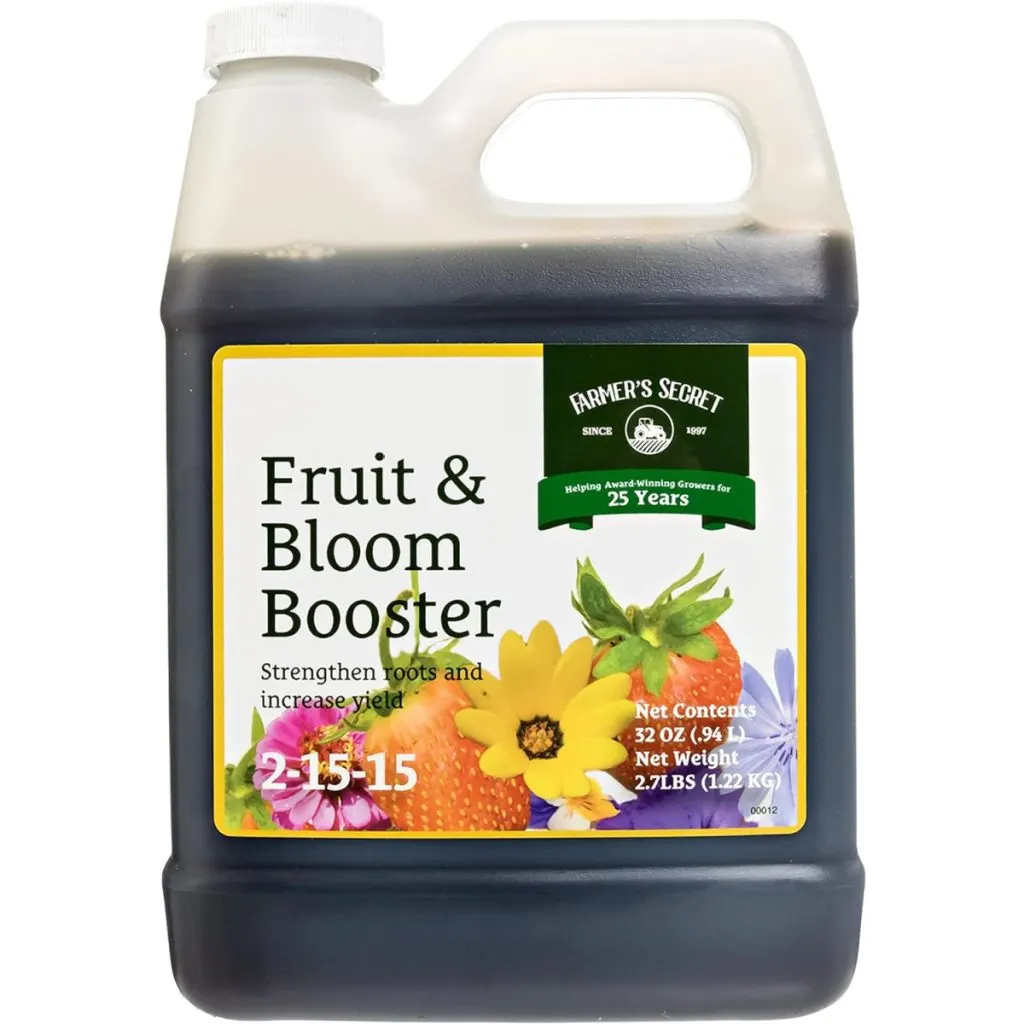If you’ve always wanted to grow fresh cucumbers but don’t have the time or space for a full garden, then you need to try growing cucumbers in containers. Not only is it easy to do – you can grow them anywhere – whether it’s on a balcony, a deck or your sunny back patio!
Cucumbers are an excellent choice for gardeners working with limited space. Thanks to their compact root system, they adapt well to container planting and won’t quickly outgrow their pots. In fact, as long as you have a spot with consistent sunlight, you can grow cucumbers just about anywhere.
Even better – growing cucumbers in convenient spots like a deck or patio also puts your harvest within easy reach for watering, fertilizing – and for quick picking right when you need it!

3 Simple Secrets To Growing Cucumbers In Containers
To grow cucumbers in pots – beyond making sure your plants get the daily sunlight they need, success really comes down to 3 important factors – putting your plants in the right container, giving them the right soil – and making sure you feed them for strong growth and production.
#1 – Select The Right Size Container
When growing cucumbers in containers, it’s important to choose the right size pot to help your plants thrive. At a minimum, the container should be about 8 inches deep and around 12 inches wide.
This gives the roots enough room to stretch out and grow properly. If the pot is too small, the roots can become cramped, which limits the plant’s ability to grow and produce.
But the benefits of using a larger container go well beyond just root space. Bigger pots offer two other major advantages that can make a real difference in the success of your cucumber plants. First, they hold more soil, which helps retain moisture for longer periods.
Because cucumbers need a lot of water to stay healthy and continue producing, this added moisture retention is key. Small containers dry out quickly, especially in hot weather, and that can stress the plant and reduce both growth and yield.

Secondly, larger pots help regulate soil temperature more effectively. When growing cucumbers in small containers, the soil can heat up too much during the day or cool off too much at night. These quick changes in temperature can shock the roots and slow down plant development.
With a larger volume of soil, temperatures stay more stable, protecting the roots from those extremes. One of the best container options for cucumbers is a simple 5 gallon bucket. 5 gallon buckets provide enough depth and width for the roots to spread out comfortably, and they also hold plenty of soil to maintain moisture and temperature.
Don’ Forget The Drain Holes!
Besides being the right size, your container needs good drainage. If water sits in the soil too long, cucumber roots can and will rot. When this happens, the leaves will turn yellow, and the plant will slow down or stop producing flowers.
If your pot or bucket only has one hole in the bottom, drill a few more using a 1/2″ or 3/4″ bit. For 5-gallon buckets or large containers, adding extra holes on the lower sides can help water drain better.
To improve drainage even more, add some rocks, twigs, or chunky mulch to the bottom before filling with soil. This helps keep the drain holes clear so water can flow out easily.
Listen In Below To Our Podcast On How To Grow Vegetables In 5 Gallon Buckets!
2. You Need Great Soil To Grow Cucumbers In Containers
To grow their best, vegetable plants need rich, loose, and well-draining soil – and cucumbers are no exception to that rule. Regular garden soil just isn’t ideal for container growing. It’s often too heavy and doesn’t drain well enough for healthy root development.
Instead, use a high-quality potting mix or make your own blend at home. The soil should be lightweight and packed with nutrients. Look for potting mixes that contain perlite, a natural, white, pebble-like material often mistaken for Styrofoam. Perlite helps create air pockets in the soil, making it easier for roots to grow and water to drain properly.
To give your plants even more nutrients, mix in a few cups of compost or worm castings before planting. These natural boosters enrich the soil and supply your cucumbers with the nutrients they need to grow strong and productive. Affiliate Link: 100% All Natural Worm Castings
3. Fertilize For Success
Last but not least – when growing cucumbers in containers, you have to fertilize your plants regularly for success! One of the most important steps to growing healthy, productive container plants is giving them an extra boost of nutrients throughout the season.
Whether you’re growing vegetables or flowers, potted plants can’t pull nutrients from surrounding soil like plants in the ground. Instead, they rely only on what’s in their container. And that supply runs out quicker than you might think.

As the plant grows and uses up the nutrients in the soil, it can begin to slow down, stop producing, or even become weak and unhealthy. That’s why it’s so important to feed container plants regularly with a gentle, consistent dose of fertilizer. But the key is gentle and consistent!
A steady supply of nutrients helps them keep growing strong, blooming, and producing fruits or vegetables all summer long. The best approach for fertilizing container plants is to go with a lighter feeding more often, rather than giving large doses every now and then.
Using a diluted mix (1/2 of recommended dose) of liquid fertilizer every ten to fourteen days can work wonders. The milder option from diluting won’t overwhelm the plants, but they’ll keep a steady flow of energy going to the roots. See our article: How To Fertilize Cucumbers In The Summer
Using The Right Fertilizer
When fertilizing, select a liquid fertilizer that has a higher percentage of potassium and phosphorous compared to nitrogen. This will help your plants concentrate on blooming and production – and not just growing big. Affiliate Link: Bloom & Boost Fertilizer Liquid Concentrate
Be careful not to overfeed, though. Too much fertilizer at once can push the plant to grow lots of leaves but fewer flowers or fruits. That’s why the “low and slow” method works best. It gives plants what they need in small doses, helping them thrive over time without the risk of overgrowth or nutrient burn.
Here is to growing cucumbers in containers this year – and to a bountiful harvest all summer long!
Simple Garden Life
Follow Our Facebook Page For Even More Great Tips! Simple Garden Life Facebook Page
Simple Garden Life is a website dedicated to keeping gardening fun, simple and enjoyable! We publish two new articles each week along with a new garden podcast episode every two weeks. This article may contain affiliate links.
